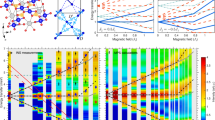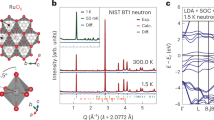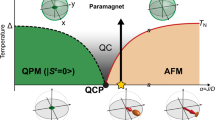Abstract
Conventional crystalline magnets are characterized by symmetry breaking and normal modes of excitation called magnons, with quantized angular momentum ħ. Neutron scattering correspondingly features extra magnetic Bragg diffraction at low temperatures and dispersive inelastic scattering associated with single magnon creation and annihilation. Exceptions are anticipated in so-called quantum spin liquids, as exemplified by the one-dimensional spin-1/2 chain, which has no magnetic order and where magnons accordingly fractionalize into spinons with angular momentum ħ/2. This is spectacularly revealed by a continuum of inelastic neutron scattering associated with two-spinon processes. Here, we report evidence for these key features of a quantum spin liquid in the three-dimensional antiferromagnet NaCaNi2F7. We show that despite the complication of random Na1+–Ca2+ charge disorder, NaCaNi2F7 is an almost ideal realization of the spin-1 antiferromagnetic Heisenberg model on a pyrochlore lattice. Magnetic Bragg diffraction is absent and 90% of the neutron spectral weight forms a continuum of magnetic scattering with low-energy pinch points, indicating NaCaNi2F7 is in a Coulomb-like phase. Our results demonstrate that disorder can act to freeze only the lowest-energy magnetic degrees of freedom; at higher energies, a magnetic excitation continuum characteristic of fractionalized excitations persists.
This is a preview of subscription content, access via your institution
Access options
Access Nature and 54 other Nature Portfolio journals
Get Nature+, our best-value online-access subscription
$29.99 / 30 days
cancel any time
Subscribe to this journal
Receive 12 print issues and online access
$209.00 per year
only $17.42 per issue
Buy this article
- Purchase on Springer Link
- Instant access to full article PDF
Prices may be subject to local taxes which are calculated during checkout




Similar content being viewed by others
Data availability
The data that support the plots within this paper and other findings of this study are available from the corresponding author upon reasonable request.
References
Villain, J. Insulating spin glasses. Z. Phys. B 33, 31–42 (1979).
Harris, A. B., Berlinsky, A. J. & Bruder, C. Ordering by quantum fluctuations in a strongly frustrated Heisenberg antiferromagnet. J. Appl. Phys. 69, 5200–5202 (1991).
Canals, B. & Lacroix, C. Pyrochlore antiferromagnet: A three-dimensional quantum spin liquid. Phys. Rev. Lett. 80, 2933–2936 (1998).
Canals, B. & Lacroix, C. Quantum spin liquid: The Heisenberg antiferromagnet on the three-dimensional pyrochlore lattice. Phys. Rev. B 61, 1149–1159 (2000).
Moessner, R. & Chalker, J. T. Properties of a classical spin liquid: The Heisenberg pyrochlore antiferromagnet. Phys. Rev. Lett. 80, 2929–2932 (1998).
Moessner, R. & Chalker, J. T. Low-temperature properties of classical geometrically frustrated antiferromagnets. Phys. Rev. B 58, 12049–12062 (1998).
Isakov, S. V., Gregor, K., Moessner, R. & Sondhi, S. L. Dipolar spin correlations in classical pyrochlore magnets. Phys. Rev. Lett. 93, 167204 (2004).
Henley, C. L. Power-law spin correlations in pyrochlore antiferromagnets. Phys. Rev. B 71, 014424 (2005).
Henley, C. L. The Coulomb phase in frustrated systems. Annu. Rev. Condens. Matter Phys. 1, 179–210 (2010).
Fennell, T. et al. Magnetic Coulomb phase in the spin ice Ho2Ti2O7. Science 326, 415–417 (2009).
Isoda, M. & Mori, S. Valence-bond crystal and anisotropic excitation spectrum on 3-dimensionally frustrated pyrochlore. J. Phys. Soc. Jpn 67, 4022–4025 (1998).
Moessner, R., Sondhi, S. L. & Goerbig, M. O. Quantum dimer models and effective Hamiltonians on the pyrochlore lattice. Phys. Rev. B 73, 094430 (2006).
Huang, Y., Chen, K., Deng, Y., Prokof’ev, N. & Svistunov, B. Spin-ice state of the quantum Heisenberg antiferromagnet on the pyrochlore lattice. Phys. Rev. Lett. 116, 177203 (2016).
Tchernyshyov, O., Moessner, R. & Sondhi, S. L. Order by distortion and string modes in pyrochlore antiferromagnets. Phys. Rev. Lett. 88, 067203 (2002).
Conlon, P. H. & Chalker, J. T. Absent pinch points and emergent clusters: Further neighbor interactions in the pyrochlore Heisenberg antiferromagnet. Phys. Rev. B 81, 224413 (2010).
Lee, S.-H. et al. Emergent excitations in a geometrically frustrated magnet. Nature 418, 856–858 (2002).
Kamazawa, K., Park, S., Lee, S.-H., Sato, T. J. & Tsunoda, Y. Dissociation of spin objects in geometrically frustrated CdFe2O4. Phys. Rev. B 70, 024418 (2004).
Chung, J.-H. et al. Statics and dynamics of incommensurate spin order in a geometrically frustrated antiferromagnet CdCr2O4. Phys. Rev. Lett. 95, 247204 (2005).
Tomiyasu, K. et al. Molecular spin resonance in the geometrically frustrated magnet MgCr2O4 by inelastic neutron scattering. Phys. Rev. Lett. 101, 177401 (2008).
Bellier-Castella, L., Gingras, M. J. P., Holdsworth, P. C. W. & Moessner, R. Frustrated order by disorder: The pyrochlore anti-ferromagnet with bond disorder. Can. J. Phys. 79, 1365–1371 (2001).
Saunders, T. E. & Chalker, J. T. Spin freezing in geometrically frustrated antiferromagnets with weak disorder. Phys. Rev. Lett. 98, 157201 (2007).
Arnab Sen & Moessner, R. Topological spin glass in diluted spin ice. Phys. Rev. Lett. 114, 247207 (2015).
Gardner, J. S. et al. Glassy statics and dynamics in the chemically ordered pyrochlore antiferromagnet Y2Mo2O7. Phys. Rev. Lett. 83, 211–214 (1999).
Silverstein, H. J. et al. Liquidlike correlations in single-crystalline Y2Mo2O7: An unconventional spin glass. Phys. Rev. B 89, 054433 (2014).
Krizan, J. W. & Cava, R. J. NaCaCo2F7: A single-crystal high-temperature pyrochlore antiferromagnet. Phys. Rev. B 89, 214401 (2014).
Krizan, J. W. & Cava, R. J. NaCaNi2F7: A frustrated high-temperature pyrochlore antiferromagnet with S = 1 Ni2+. Phys. Rev. B 92, 014406 (2015).
Sanders, M. B., Krizan, J. W., Plumb, K. W., McQueen, T. M. & Cava, R. J. NaSrMn2F7, NaCaFe2F7, and NaSrFe2F7: novel single crystal pyrochlore antiferromagnets. J. Phys. Condens. Matter 29, 045801 (2017).
Coldea, R. et al. Direct measurement of the spin Hamiltonian and observation of condensation of magnons in the 2d frustrated quantum magnet Cs2CuCl4. Phys. Rev. Lett. 88, 137203 (2002).
Ross, K. A., Savary, L., Gaulin, B. D. & Balents, L. Quantum excitations in quantum spin ice. Phys. Rev. X 1, 021002 (2011).
Hohenberg, P. C. & Brinkman, W. F. Sum rules for the frequency spectrum of linear magnetic chains. Phys. Rev. B 10, 128–131 (1974).
Conlon, P. H. & Chalker, J. T. Spin dynamics in pyrochlore Heisenberg antiferromagnets. Phys. Rev. Lett. 102, 237206 (2009).
Zhitomirsky, M. E. & Chernyshev, A. L. Colloquium: Spontaneous magnon decays. Rev. Mod. Phys. 85, 219–242 (2013).
Ross, K. A., Krizan, J. W., Rodriguez-Rivera, J. A., Cava, R. J. & Broholm, C. L. Static and dynamic XY-like short-range order in a frustrated magnet with exchange disorder. Phys. Rev. B 93, 014433 (2016).
Ramirez, A. P., Hessen, B. & Winklemann, M. Entropy balance and evidence for local spin singlets in a kagome-like magnet. Phys. Rev. Lett. 84, 2957–2960 (2000).
Nakatsuji, S. et al. Spin disorder on a triangular lattice. Science 309, 1697–1700 (2005).
Bergman, D., Alicea, J., Gull, E., Trebst, S. & Balents, L. Order-by-disorder and spiral spin-liquid in frustrated diamond-lattice antiferromagnets. Nat. Phys. 3, 487–491 (2007).
Halperin, B. I. & Saslow, W. M. Hydrodynamic theory of spin waves in spin glasses and other systems with noncollinear spin orientations. Phys. Rev. B 16, 2154–2162 (1977).
Podolsky, D. & Kim, Y. B. Halperin–Saslow modes as the origin of the low-temperature anomaly in NiGa2S4. Phys. Rev. B 79, 140402 (2009).
Lee, S.-H. et al. Less than 50% sublattice polarization in an insulating S = 3/2 kagome antiferromagnet at T ≈ 0. Phys. Rev. B 56, 8091–8097 (1997).
Reimers, J. N., Berlinsky, A. J. & Shi, A.-C. Mean-field approach to magnetic ordering in highly frustrated pyrochlores. Phys. Rev. B 43, 865–878 (1991).
Elhajal, M., Canals, B., Sunyer, R. & Lacroix, C. Ordering in the pyrochlore antiferromagnet due to Dzyaloshinsky–Moriya interactions. Phys. Rev. B 71, 094420 (2005).
Chern, G.-W., Moessner, R. & Tchernyshyov, O. Partial order from disorder in a classical pyrochlore antiferromagnet. Phys. Rev. B 78, 144418 (2008).
Brown, P. J. International Tables for Crystallography (ed. Prince, E.) 454–461 (Springer, Berlin, 2006).
Rodriguez, J. A. et al. MACS a new high intensity cold neutron spectrometer at NIST. Meas. Sci. Technol. 19, 034023 (2008).
Zaliznyak, I. A. et al. Polarized neutron scattering on HYSPEC: the hybrid spectrometer at SNS. J. Phys. Conf. Ser. 862, 012030 (2017).
Arnold, O. et al. Mantid—Data analysis and visualization package for neutron scattering and μSR experiments. Nucl. Instrum. Methods Phys. Res. A 764, 156–166 (2014).
Hukushima, K. & Nemoto, K. Exchange Monte Carlo method and application to spin glass simulations. J. Phys. Soc. Jpn 65, 1604–1608 (1996).
Acknowledgements
We are grateful to Y. Wan for enlightening discussions. This work benefited from many discussions with, and insights passed by, O. Tchernyshyov. We would also like to thank R. Moessner, J. Chalker and S. Todadri for critical reading of this manuscript. Work at the Institute for Quantum Matter was supported by the US Department of Energy, Office of Basic Energy Sciences, Division of Material Sciences and Engineering under grant DE-FG02-08ER46544. A.S. and C.B. were funded by the Gordon and Betty Moore Foundation under the EPIQS program GBMF no. 4532. Access to MACS was provided by the Center for High Resolution Neutron Scattering, a partnership between the National Institute of Standards and Technology and the National Science Foundation under Agreement No. DMR-1508249. A portion of this research used resources at the Spallation/Neutron Source, a DOE Office of Science User Facility operated by the Oak Ridge National Laboratory. This work was supported by the Paul Scherrer Institut by providing the supermirror analyser as a temporary loan to Oak Ridge National Laboratory. We gratefully acknowledge the Johns Hopkins Homewood High Performance Cluster (HHPC) and the Maryland Advanced Research Computing Center (MARCC), funded by the State of Maryland, for computing resources.
Author information
Authors and Affiliations
Contributions
K.W.P., A.S., B.W., J.A.R. and Y.Q. performed the neutron scattering experiments. K.W.P. performed the specific heat measurements and analysed all experimental data. J.W.K. and R.J.C. synthesized and characterized the single-crystal sample. H.J.C and S.Z. performed Monte Carlo simulations and self-consistent Gaussian approximation calculations, along with assisting with the theoretical interpretation. K.W.P., C.L.B. and H.J.C. wrote the manuscript with input from all co-authors. C.L.B. oversaw all aspects of the project.
Corresponding author
Additional information
Publisher’s note: Springer Nature remains neutral with regard to jurisdictional claims in published maps and institutional affiliations.
Supplementary information
Supplementary information
Supplementary Text, Figures 1–5 and References
Rights and permissions
About this article
Cite this article
Plumb, K.W., Changlani, H.J., Scheie, A. et al. Continuum of quantum fluctuations in a three-dimensional S = 1 Heisenberg magnet. Nature Phys 15, 54–59 (2019). https://doi.org/10.1038/s41567-018-0317-3
Received:
Accepted:
Published:
Issue Date:
DOI: https://doi.org/10.1038/s41567-018-0317-3
This article is cited by
-
Proximate spin liquid and fractionalization in the triangular antiferromagnet KYbSe2
Nature Physics (2024)
-
Momentum-independent magnetic excitation continuum in the honeycomb iridate H3LiIr2O6
Nature Communications (2023)
-
Spin-ice physics in cadmium cyanide
Nature Communications (2021)
-
Hybridized quadrupolar excitations in the spin-anisotropic frustrated magnet FeI2
Nature Physics (2021)
-
Dichotomy in temporal and thermal spin correlations observed in the breathing pyrochlore LiGa1−xInxCr4O8
npj Quantum Materials (2021)



